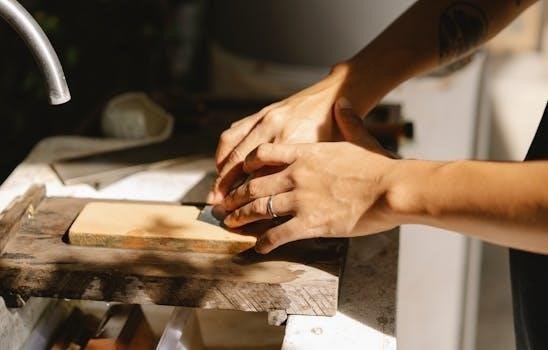Achieving a perfectly sharp knife edge requires precision, and maintaining a consistent sharpening angle is crucial. Angle guides are essential tools for both beginners and experienced sharpeners, ensuring consistent results every time. They help eliminate guesswork, allowing anyone to get a perfect edge in minutes.
The Importance of Consistent Sharpening Angles
Maintaining a consistent sharpening angle is paramount for achieving and preserving a knife’s optimal sharpness and cutting performance. Inconsistent angles lead to uneven edges, making the knife less effective and more prone to damage. When the sharpening angle varies, different parts of the blade may have different bevel angles, causing the edge to become dull quickly and requiring more frequent sharpening. This can lead to a loss of the blade’s intended geometry and performance.
A consistent angle also ensures that the blade is sharpened uniformly, resulting in a sharper, more durable edge that can withstand regular use without chipping or breaking. Moreover, a consistent angle contributes to the longevity of the knife, as it prevents unnecessary wear and tear on the blade. By using angle guides, you can eliminate the guesswork and maintain the correct angle, leading to superior sharpness, enhanced durability, and longer knife life. This precision also contributes to safer knife handling, reducing the risk of accidents caused by dull or poorly sharpened blades.

Types of Knife Sharpening Angle Guides
Various types of angle guides cater to different needs and preferences. These include clip-on, magnetic base, and adjustable guides. Each type offers unique advantages for maintaining consistent sharpening angles during the process.
Clip-on Angle Guides
Clip-on angle guides are a simple and effective way to maintain the perfect edge angle when using a whetstone. They typically attach to the spine of the knife, helping to maintain a consistent angle throughout the sharpening process. These guides often feature ceramic skates that glide smoothly across the whetstone, ensuring the proper distance is kept to reproduce a factory edge. Clip-on guides are versatile and can be used on various flat sharpening surfaces, including both water and oil stones. They are available in different sizes to accommodate different blade widths, with larger guides for wider blades and smaller guides for narrow ones. These guides are designed to help users achieve consistent angles, making them ideal for those new to sharpening or anyone seeking more precision. While some may find them to be a one-size-fits-all solution, they are a helpful starting point for many. Some guides are made from durable plastic with protective ceramic layers, while others are constructed from steel for long-lasting use.
Magnetic Base Angle Guides
Magnetic base angle guides offer a secure and convenient way to maintain a consistent sharpening angle. These guides are designed with a magnetic base that attaches to sharpening stones made of ferrous metal. This magnetic connection ensures the guide stays firmly in place during the sharpening process, preventing slippage and providing a stable platform. The use of a magnetic base makes these guides particularly useful for those who prefer to work with metal-based sharpening stones. Some magnetic guides come with integrated universal angles, allowing users to choose from various preset angles, such as 14, 17, 20, or 25 degrees. This feature makes it easier to select the correct angle for different types of knives. The magnetic base provides ease of use and helps achieve consistent results. These guides are designed to help users sharpen their knives with precision and confidence. The magnetic base ensures the sharpening process is both efficient and effective.
Adjustable Angle Guides
Adjustable angle guides provide the versatility to customize the sharpening angle to suit specific needs. These guides allow users to select a wide range of angles, making them suitable for various knife types and purposes. Whether you require a more acute angle for delicate tasks or a wider angle for heavier-duty cutting, an adjustable guide can accommodate your specific requirements. This feature is particularly useful for those who work with different kinds of knives that need various edge angles. Adjustable guides are designed to help users achieve precise and consistent results, regardless of the type of blade being sharpened. Some models feature clear markings that make it easy to select and lock in the desired angle. This level of control allows users to fine-tune their sharpening technique and achieve the best possible edge. The ability to adjust the angle makes these guides a valuable tool for anyone seeking professional-quality sharpening results. It provides flexibility and ensures that every knife gets the appropriate edge angle.
Understanding Sharpening Angles
The sharpening angle refers to the angle between the blade and the sharpening stone. Different knife types require different angles. Sharper edges use steeper angles, but these edges are more prone to chipping. Understanding angles is key to effective sharpening.
Common Sharpening Angles for Different Knife Types
The ideal sharpening angle varies based on the knife’s intended use. Straight razors, designed for soft materials, often have the lowest angles, around 7 to 8 degrees per side. Japanese knives, known for their precision, commonly use 15 to 17-degree angles, achieving a total angle of 30 to 34 degrees. These angles are suitable for slicing meats and soft items. Most Western knives, including kitchen and pocket knives, typically range from 17 to 22 degrees per side, offering a balance of sharpness and durability; Outdoor and hunting knives frequently have angles between 22 to 30 degrees, prioritizing durability for tougher tasks. Edged tools like axes and machetes often have angles exceeding 30 degrees. Selecting the correct angle is essential for optimal performance and longevity of the blade.

Using Angle Guides Effectively
To use angle guides effectively, attach the guide to your knife’s spine, maintaining consistent contact with the sharpening stone throughout the process. This ensures the correct angle is reproduced for a sharp and durable edge.
Step-by-Step Guide to Using Angle Guides
Using an angle guide can significantly improve your knife sharpening process. First, select the appropriate angle guide based on your knife type and desired edge. For kitchen knives, a 15 to 20-degree guide is often ideal, while pocket knives might benefit from a 20 to 25-degree angle. Begin by securely attaching the angle guide to the spine of your knife, ensuring it’s firmly in place. Next, position your sharpening stone on a stable surface. Now, place the knife and angle guide onto the stone, making sure the ceramic or steel of the guide is in contact with the stone. Maintain gentle, even pressure as you move the knife across the stone. Repeat this process on both sides of the blade, using consistent strokes and pressure; Avoid any rocking or tilting motion during the process. Monitor the edge to ensure even sharpening. For best results, work on the entire length of the blade, from the heel to the tip. After sharpening, clean the blade and angle guide before storing them away.

Alternative Methods for Maintaining Sharpening Angle
While angle guides are helpful, alternative methods like the Sharpie marker technique exist. By coloring the bevel with a marker and sharpening until the ink is gone, you can visually track your progress. This method ensures consistent angle maintenance.
The Sharpie Marker Method
For those who prefer freehand sharpening, the Sharpie marker method is a tried and true technique for maintaining a consistent sharpening angle. This method involves coloring the entire bevel of your knife’s edge with a marker. As you sharpen, the ink will be removed from the areas where the stone makes contact with the blade. The goal is to remove all the marker ink evenly, ensuring you are maintaining the desired angle throughout the sharpening process. This method acts as a visual guide, making it easier to identify any inconsistencies in your sharpening technique. If the ink is removed more from the cutting edge, it indicates that the angle is too high; if the ink remains closer to the shoulder of the bevel, the angle is too low. By paying close attention to the marker removal pattern, you can adjust your angle to achieve a consistent and sharp edge.

Conclusion
In conclusion, maintaining the correct sharpening angle is essential for achieving a sharp and durable edge on your knives. Whether you choose to use angle guides, the Sharpie marker method, or another technique, consistency is key. Understanding your knife’s bevel, intended use, and the steel it is made of will help you determine the appropriate sharpening angle. Angle guides offer a convenient and precise method for those who struggle with freehand sharpening, while the Sharpie method provides a visual reference for maintaining the desired angle. Ultimately, the best sharpening method is the one that best suits your needs and preferences. By incorporating the appropriate methods and tools, you can ensure that your knives remain sharp, safe, and efficient for all your cutting needs.